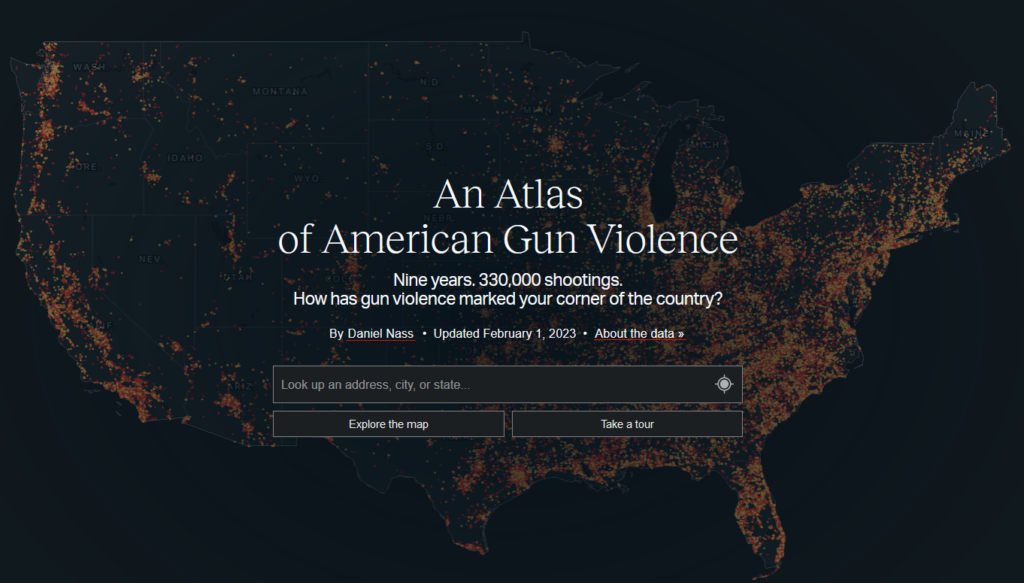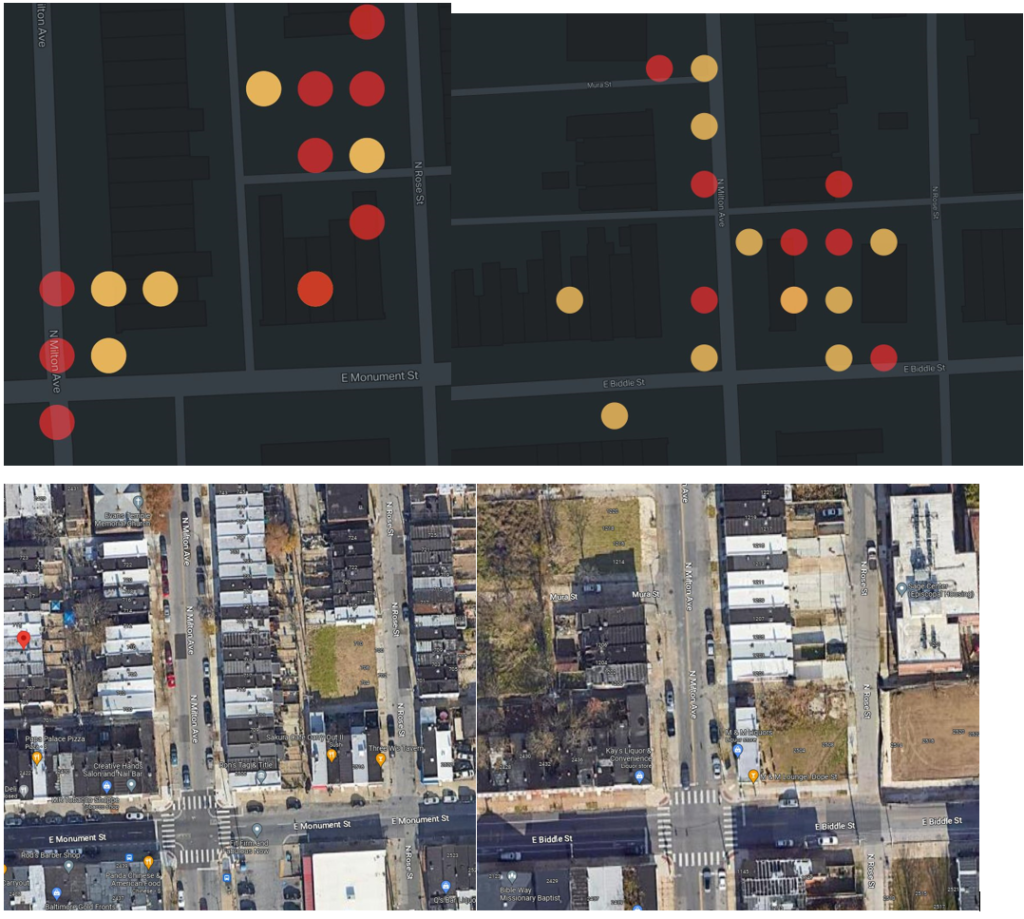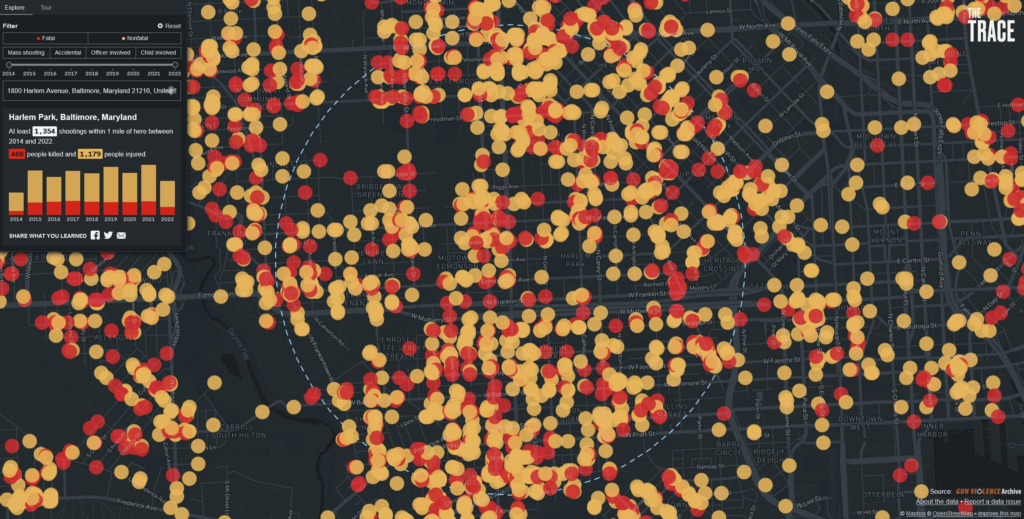Shooting victims on a map
The Trace has an online map of gunshot victims and fatalities over the past 9 years.
It’s not perfect data. It seems vastly undercount (or not count) non-fatal shootings in areas without much press. And in New York City, it undercounts shooting incidents and victims by 17% and 20%. OK… but it’s still a pretty fabulous map. Just don’t assume it gets 100%. What it does get is enough.

This map is both amazing and terrifying. I compared the neighborhood I policed in Baltimore with where I live in Queens. Over 9 years in a 1-mile radius (AKA: π^2 mile): 1,011 shootings vs 39. Don’t shift focus to anything else. Nothing can get fixed with that level of violence.


This gap in the center there in Baltimore is pretty amazing. Nine years and not a single person shot? Much of it was vacant most of those 9 years, but still. When I was there it would have dots like everywhere else. Hopkins’ massive East Baltimore Development Inc.
Here’s an academic report/summary. 20 years later, more people are living there would have been, had the neighborhood not been torn down. (I do find it odd there’s not a substantive word about crime.)
But back to the violence. Look at these corners of N. Milton (one at Monument the other at Biddle). It’s hard to overstate what 17 shootings or 9 murders means (over 9 years, 2014-2022).

And if it’s all systemic and redlining and food deserts, why does violence vary so much block to block? Shootings don’t just happen. A person has to shoot somebody. And that person lives somewhere, and hangs out somewhere. And if you don’t address that person, shootings happen.Here are two corners a 5-min walk away on Madison St, a major bus corridor. Both corners are close to the historic Northeast Market (great place), a real Baltimore market filled with fresh food and produce. Neither corner was Redlined, FWIW (unlike Fells Point and Canton.)

So tell me which of these blocks has 12 shootings and which has zero? What macro or systemic or historic issue affects the 2500 block of Madison but not the 2800 block? And why? They’re identical in every way EXCEPT for the violence. It’s the repeat violent offenders.

The problem when one says “community violence” is not only is it insulting to the good hard-working people of both blocks, it’s especially insulting to the block where there is no violence! East Baltimore is not a violent “community.” There are violent people in East Baltimore.
If you talk to residents of the 2800 block of Madison, as I have, you know what they’ll tell you? They don’t want depolicing. They want the knuckleheads on the 2500 block put away so they can walk down the street!
Now if you have a way to “rehabilitate” the knuckleheads on the 2500 block, knock yourself out. But don’t t think this whole neighborhood is bad or needs your benighted help. You’ve never been there! And stop thinking the most violent offenders represent “the community.”
The violence in Baltimore has gotten worse since I policed there more than 20 years ago. That’s what is tragic. Because it had been getting better until 2015. And then Freddie Gray died in police custody and policing had to be reformed and reimagined and everything went to hell.
So there is more violence and it’s spread to some placed that surprise me (which in Baltimore usually means the working-class Black residents people move/flee in terror, as one would a pogrom).
But mostly it’s trans-generational violence and trans-generational poverty/welfare/drug addiction coming from the same damn blocks and the same damn 15-year-generation non-nuclear family cycles. And yes, they do need help. And other people need protection. Nothing has changed.
So what is the most violent location or mile is? I don’t know. But I found this dangerous location. W Hill St, Richmond, VA. 24 people shot in 9 years. I mean 2 cops, 24-hours (12 cops+Sgt) could stop 22 of these shootings. Is that worth ~$1.3 million a year? I think it is. What is a life worth?

1800 Harlem Ave in Baltimore lists 1,354 people shot and 468 people murdered over 9 years within 1 mile. Real people. I dare you to find worse. And it didn’t use to be so bad. It was bad in 2014, but it was half as bad. It didn’t have to get worse, but for bad leadership.


This is one of the secret nicest neighborhoods in Baltimore. My sergeant used to live here. Surrounded by gunfire, but nobody shot in 9 years, right next to Lake Montebello, hell of a crab feast at St Francis of Assisi, and BLM signs next to a rare Formstone detached house.

Violence is local. Hyper local. It’s no surprise there are entire neighborhoods without gun violence. But what people don’t understand is that even in so-called violent neighborhoods there are blocks without violence next to blocks with violence. Because it’s the people, people.
No amount of “community investment” is going to reduce violence on the 2800 block of E Madison Street. Why because literally nobody there is shooting! they may need help; they need protection from violence. It’s not miasma. It’s not Covid. To reduce violence focus on the places violence happens & the people committing violence, repeatedly.
So what are non-shooty areas? Taking population density into account. This two-mile-diameter circle around Porter Square, Cambridge/Somerville, Massachusetts may qualify. This area probably has > 60,000 people and had two shootings over nine years. (Whereas ~3.141593 square miles of East Baltimore has probably fewer than 20,000 people and 1,011 shootings.)

2 vs 418. Richer whiter Porter Square in Cambridge/Somerville and poorer blacker Dorchester/Roxbury in Boston. Guess where “progressive” support for #defund is strongest? You know where this is going. But then doesn’t that make sense? They have more money and don’t need police.

This is kind of interesting. Or not. But a minority poorer and more violent area around Blue Hill Ave in Dorchester voted 7% for Trump. Might not sound like a lot. But it’s nearly twice that of the richer whiter areas around Porter Square.

There are so many was to parse data. Here are shootings and officer-involved shootings in the same area in Dorchester. Of course those two are correlated.

Now if all you care about is “police violence” and working toward #abolition, I’ll throw you a free one. Misses the big picture, but it’s true: In a mile radius in Dorchester, MA, more black men have been shot and killed by police than total # of people shot around Porter Square.

Here are police-involved shootings (people shot by cops) in East Baltimore. Might be interesting as a sort of a base line for a high violence area. ~10. So where to?

East New York? 8. Around where I live. 2. I remember the killing. Tragic. 86 year old man murdered his 65-year old daughter and then turned the gun on cops. Luckily the cops shot him first. The other was a good shoot, too.

But where do cops shoot a lot of people? This is where I think it might get interesting. Top cities on my data? Abq: 12. St Lo: 13. But the circle around “International District” in Abq has 131 shootings. This part of North St Louis? 536. I think that matters.

Pueblo, Colorado, which I recently commenting on as a place where cops shoot too often, there’s a circle with 9 cop-involved shootings over 9 years. And only 72 shootings in the circle. Those ratios should be more in sync. There’s no “right number,” but that’s not a good ratio, 8:1.

In selected one-mile-radius circles: East Baltimore has a ratio of shootings to # shot by cops of 110 : 1.
Minneapolis 100 : 1 (506 & 5)
Dorchester, Boston, Mass, 60 : 1.
North St Louis 41 : 1.
ABQ 11 : 1.
Spokane (pictured) 5.8 : 1 (64 & 11).
Tacoma (pictured) 5.2 : 1 (31 & 6).

Each police-involved shooting needs to be judged morally and legally individually. But still, en masse, there should be some relations between people shooting people and cops shooting people shooting people. And the differences is those ratios from 5 : 1 to 100 : 1? Something important is there. Maybe cops aren’t engaging people enough (which would lead to fewer cops shooting people). But maybe cops in Spokane and Tacoma need better threat-assessment training.
I also notice visually that shootings are much less clustered / more spread out, out west. Maybe that’s significant? IDK. I’ve never heard that mentioned before. Compare LA and Portland with New York and Philadelphia. (scales vary)

The Philly map interesting because either Camden shooters are _much_ more lethal than their Pennsylvania brethren or the data isn’t accurate for all the Camden shootings. I strongly suspect the latter. One would always expect more yellow than red. That’s big red flag on data validity. I mean, it does say “at least,” but still. I notice this is rural areas too, very few non-fatal shootings reported.

So I spot-checked NYC, since I do have accurate NYPD data for NYC. I’ll pick 2019. I’ve got 777 shooting incidents and 923 shooting victims. They’ve got 630 incidents and 762 victims. The Trace missed 19% of incidents and 17% of victims. That’s substantial, but not fatal.